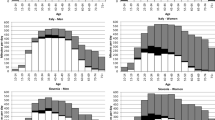Abstract
Being crunched for time is an important aspect of life quality. Although Denmark is a country known for gender-equality, on average mothers are more time-crunched than fathers. We show this using a representative sample of Danish dual-earner couples with at least one child aged 0–10 years. We analyze the determinants of time-crunch in relation to work factors for the individual as well as the spouse and find significant gender differences. One result is that longer working hours are associated with more time-crunch for both mothers and fathers, whereas the amount of housework only matters for mothers. The results show that men and women have different working conditions, which partly explains the gendered time-crunch.
Similar content being viewed by others
References
Beaujot, R., & Andersen, R. (2007). Time-crunch: Impact of time spent in paid and unpaid work, and its division in families. Canadian Journal of Sociology/Cahiers Canadiens de Sociologie, 32(3), 295–315.
Frederick, J. A. & Fast, J. E. (2001). Enjoying work: An effective strategy in the struggle to juggle? Enjoying work: An effective. Canadian Social Trends, 2001(Summer), 8-11. Statistics Canada - Catalogue No. 11-008.
Hamermesh, D. S., & Lee, J. (2007). Stressed out on four continents: Time crunch or yuppie kvetch? The Review of Economics and Statistics, 89(2), 374–383.
Mattingly, M. J., & Sayer, L. C. (2006). Under pressure: Gender differences in the relationship between free time and feeling rushed. Journal of Marriage and Family, 68(1), 205–221.
Michelson, W. (1990). Childcare and the daily routine. Social Indicators Research, 23, 353–366.
Michelson, W. (1998). Time pressure and human agency in home-based employment. Loisir et société/Society and Leisure, 21(2), 455–472.
Michelson, W., & Harvey, A. S. (2000). Is teachers’ work never done?: Time-use and subjective outcomes. Radical Pedagogy 2(1).
Michelson, W., & Tepperman, L. (2003). Focus on home: What time-use data can tell about caregiving to adults. Journal of Social Issues, 59(3), 591–610.
Robinson, J. P. (1991). Your money or your time. American Demographics, 13(11), 22–26.
Robinson, J. P., & Godbey, G. (1997). Time for life: The surprising ways Americans use their time (pp. 236–237). University Park, Pennsylvania: The Pennsylvania State University Press.
Zukewich, N. & Cooke-Reynolds, M. (2003). Transitions to union formation, Statistics Canada Research Paper, 1998 No. 2.
Author information
Authors and Affiliations
Corresponding author
Additional information
Mette Deding: Any opinions expressed here are ours, and do not necessarily reflect those of our employer. We thank the editors and the two anonymous referees for helpful comments and suggestions.
Rights and permissions
About this article
Cite this article
Deding, M., Lausten, M. Gendered Time-Crunch and Work Factors in Denmark. Soc Indic Res 101, 249–253 (2011). https://doi.org/10.1007/s11205-010-9643-2
Accepted:
Published:
Issue Date:
DOI: https://doi.org/10.1007/s11205-010-9643-2




